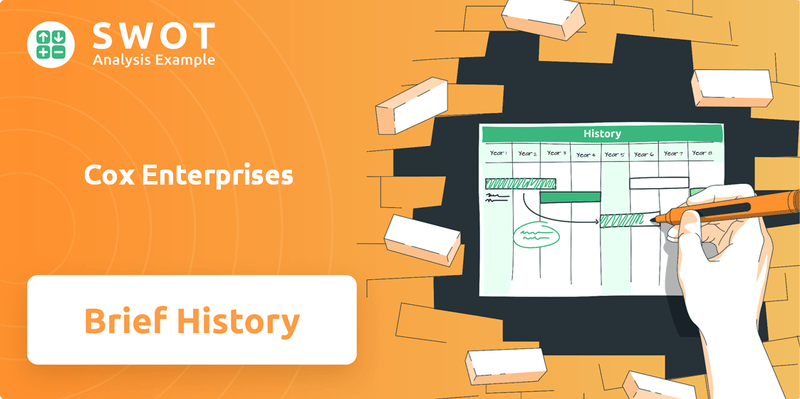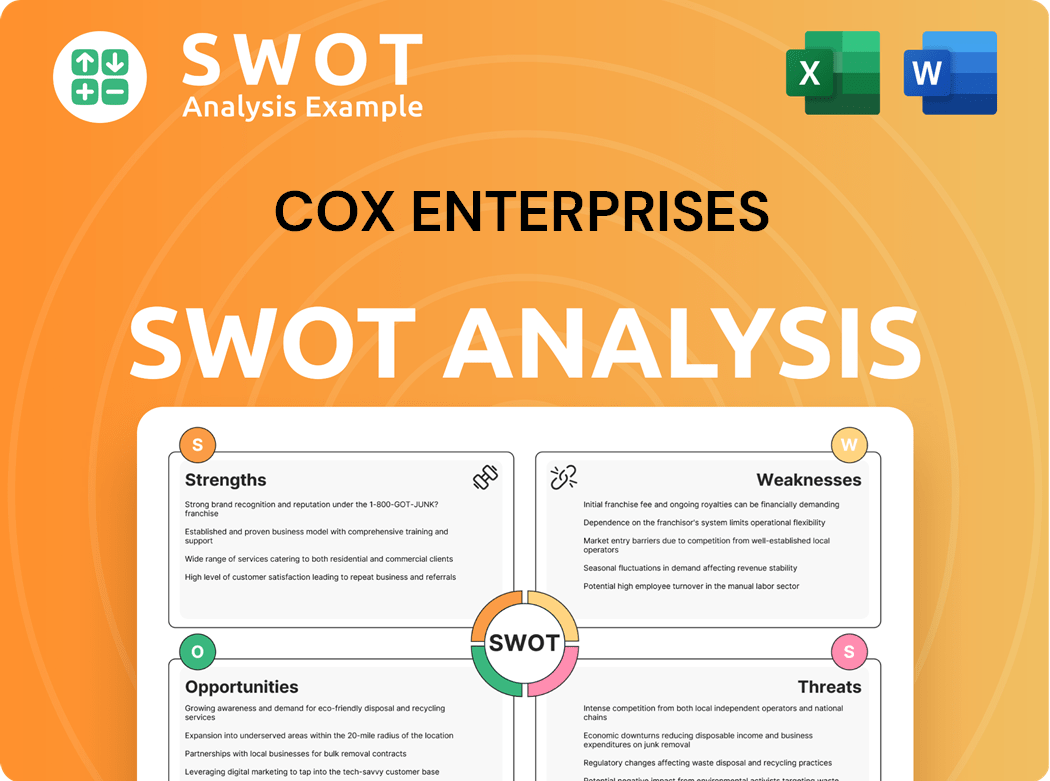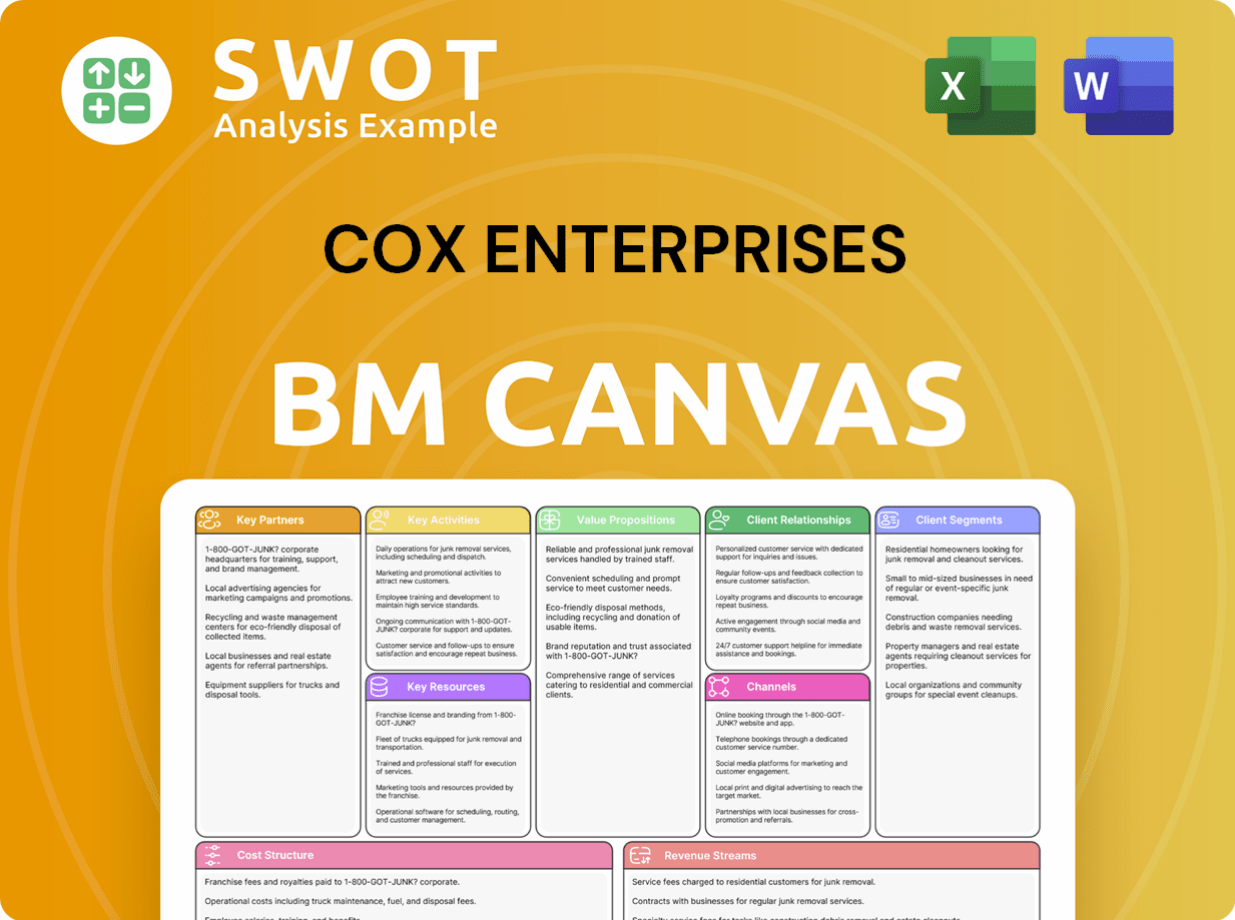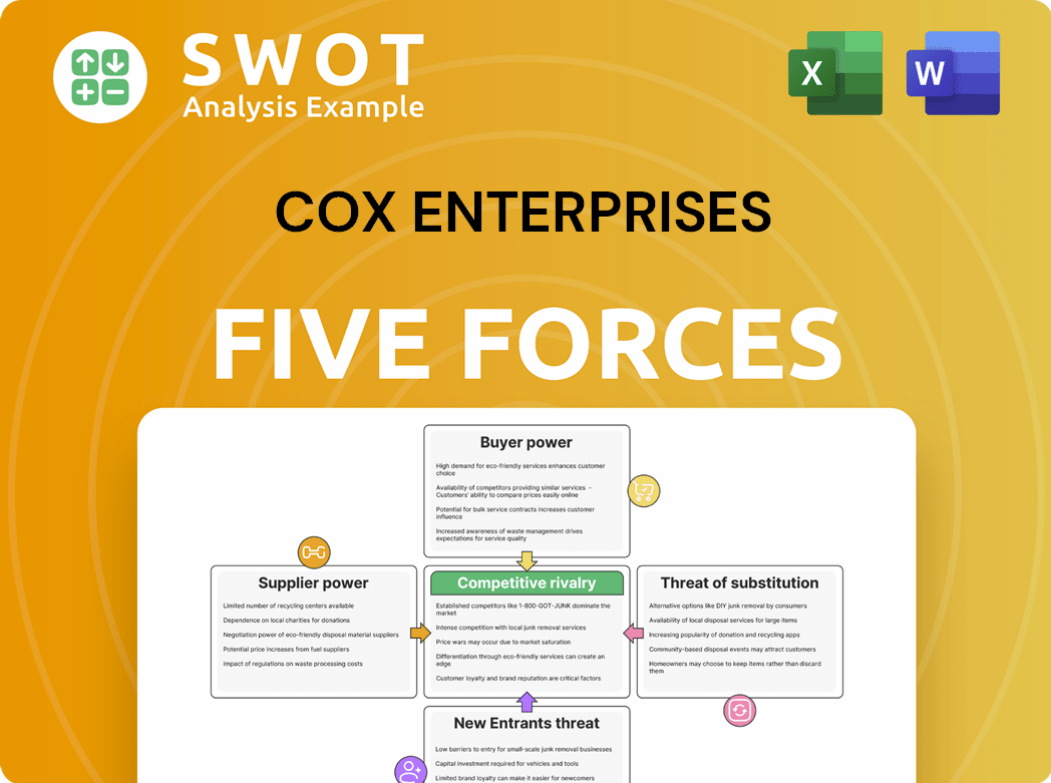Cox Enterprises Bundle
What's the Story Behind Cox Enterprises?
Journey back over a century to discover the remarkable evolution of Cox Enterprises, a privately-held powerhouse that has shaped the telecommunications, automotive services, and media landscapes. From its roots in a small Ohio newspaper, this media company has blossomed into a global conglomerate. Explore the pivotal moments and strategic decisions that have defined Cox Enterprises' enduring success.

Founded in 1898 by James M. Cox, the company's commitment to innovation and community engagement has been unwavering. Today, Cox Enterprises, through its major divisions like Cox Enterprises SWOT Analysis, Cox Communications, and Cox Automotive, continues to provide essential services and solutions. Understanding the Company history of Cox Enterprises offers valuable insights into its resilience and adaptability in a rapidly changing market, making it a compelling case study for business strategists and investors alike.
What is the Cox Enterprises Founding Story?
The story of Cox Enterprises begins in 1898, a testament to the vision of James M. Cox. Cox, born in 1870, laid the foundation for a media and automotive empire. With a loan of $26,000 from friends and family, he acquired the Dayton Evening News, later renamed the Dayton Daily News, marking the official start of the company.
James M. Cox's journey from humble beginnings to media mogul is a key part of the company's history. His background in journalism and political service, including a stint in the U.S. House of Representatives and as governor of Ohio, shaped his approach to business. Cox's unsuccessful presidential bid in 1920, with Franklin D. Roosevelt as his running mate, redirected his focus, leading to significant expansion of his newspaper business in 1923.
The company's early years were influenced by the late 19th-century cultural and economic climate. The emergence of new technologies like the telephone and phonograph reshaped the communication landscape. Cox identified an opportunity in the media sector, driven by a commitment to providing reliable information. This commitment helped shape the growth of the company, which eventually expanded its portfolio to include Cox Communications and Cox Automotive.
James M. Cox founded Cox Enterprises in 1898 in Dayton, Ohio, starting with the Dayton Daily News.
- Cox borrowed $26,000 to acquire the Dayton Evening News.
- Cox's background included journalism and political service.
- The company's growth accelerated after Cox's 1920 presidential bid.
- The late 19th-century technological advancements influenced the company's early development.
Cox Enterprises SWOT Analysis
- Complete SWOT Breakdown
- Fully Customizable
- Editable in Excel & Word
- Professional Formatting
- Investor-Ready Format

What Drove the Early Growth of Cox Enterprises?
The early growth of Cox Enterprises was marked by strategic diversification and expansion beyond its initial newspaper holdings. This period saw the company venture into broadcasting and cable television, establishing a strong presence in the media industry. Cox Enterprises also expanded into the automotive sector, laying the foundation for its diverse portfolio.
In 1935, Cox Enterprises entered broadcasting with WHIO radio in Dayton. This move was influenced by James M. Cox Jr.'s interest in radio technology. Further expansion included acquiring The Atlanta Journal and WSB radio station in 1939, solidifying its media operations. In 1948, WSB-TV in Atlanta began broadcasting, followed by WHIO-TV in Ohio in 1949.
A pivotal moment occurred in 1962 when Cox Enterprises entered the cable television market by acquiring a system in Lewistown, Pennsylvania. This made the company one of the first major broadcasters to embrace cable. By 1964, Cox's broadcasting and cable businesses were consolidated into Cox Broadcasting Corporation (CBC).
Cox Enterprises diversified further in 1965 by entering the automotive industry with the purchase of Black Book. Manheim Auctions was acquired in 1968. The newspaper interests were formally organized under the private Cox Enterprises in 1968. This expansion broadened the company's scope beyond media.
In 1982, Cox Broadcasting changed its name to Cox Communications, Inc. By 1985, Cox Communications merged back into Cox Enterprises. This consolidation created a large media conglomerate. This period of growth set the stage for the Target Market of Cox Enterprises today.
Cox Enterprises PESTLE Analysis
- Covers All 6 PESTLE Categories
- No Research Needed – Save Hours of Work
- Built by Experts, Trusted by Consultants
- Instant Download, Ready to Use
- 100% Editable, Fully Customizable

What are the key Milestones in Cox Enterprises history?
The history of Cox Enterprises is marked by significant milestones that have shaped its evolution into a diversified media and automotive services company. From its early days in newspaper publishing to its expansion into telecommunications and automotive services, Cox Enterprises has consistently adapted to changing market dynamics and technological advancements. The company's strategic decisions and investments have positioned it as a major player in several key industries, demonstrating its ability to innovate and grow over the years.
| Year | Milestone |
|---|---|
| 1898 | The company's history began with the purchase of the Dayton Evening News by James M. Cox, marking the start of its media ventures. |
| 1960s | Cox Enterprises expanded into broadcasting and cable television, diversifying its media holdings. |
| 1997 | Autotrader.com was founded, revolutionizing the online automotive classifieds market. |
| 2014 | Cox Automotive was established, consolidating the company's automotive-related businesses. |
| 2022 | Cox Enterprises acquired a majority stake in Axios, expanding its digital media presence. |
| 2024 | The company invested $1.8 billion in OpenGov, signaling a major commitment to cloud software for government agencies. |
Innovations have been central to the growth of Cox Enterprises, particularly in the digital realm. The founding of Autotrader.com in 1997 was a groundbreaking move that transformed the automotive industry. Further innovation is evident in Cox Communications' investments in fiber-optic and 5G technologies, ensuring it remains at the forefront of the telecommunications sector.
Autotrader.com's launch in 1997 revolutionized the used car market by providing a digital platform for buying and selling vehicles. This innovation showcased the company's foresight in embracing digital technologies.
The formation of Cox Automotive in 2014 brought together various automotive-related businesses under one umbrella. This strategic consolidation streamlined operations and enhanced market presence.
Cox Communications has invested over $2.5 billion in fiber-optic and 5G technologies. These investments ensure that Cox Communications can meet the growing demand for advanced digital solutions.
The acquisition of a majority stake in Axios in 2022 expanded Cox Enterprises' presence in digital media. This move strengthened the company's commitment to journalism.
In February 2024, Cox Enterprises invested $1.8 billion in OpenGov, a leader in cloud software for government agencies. This investment marked the company's largest new industry commitment.
Cox Enterprises has invested $2 billion in sustainable businesses and clean technology since 2007. The company is committed to sustainability, with goals like zero waste to landfill by 2024.
Despite its successes, Cox Enterprises has faced challenges, including adapting to changing consumer behaviors and increased competition. The company has actively addressed these challenges by diversifying its portfolio and making strategic investments in high-growth sectors. For instance, during the COVID-19 pandemic, Cox Communications experienced growth, but in 2022, macroeconomic pressures led to adjustments in marketing investments. Read more about the Growth Strategy of Cox Enterprises.
The shift to digital media and online services has required Cox Enterprises to adapt its business models. This involved strategic investments and acquisitions to remain competitive.
The telecommunications sector faces intense competition from other broadband providers. Cox Communications has addressed this through infrastructure investments and service enhancements.
Economic downturns and shifts in consumer spending can impact Cox Enterprises' performance. The company has shown resilience by adjusting its strategies and investments.
Cox Automotive and Cox Communications continually work to maintain and increase their market share. This involves innovation, customer service, and strategic partnerships.
Meeting ambitious sustainability goals, such as achieving zero waste to landfill by 2024 and becoming carbon and water neutral by 2034, presents operational challenges. These goals require ongoing investments and process improvements.
Changes in government regulations and policies can affect Cox Enterprises' operations. The company must navigate these changes to maintain compliance and adapt its strategies.
Cox Enterprises Business Model Canvas
- Complete 9-Block Business Model Canvas
- Effortlessly Communicate Your Business Strategy
- Investor-Ready BMC Format
- 100% Editable and Customizable
- Clear and Structured Layout

What is the Timeline of Key Events for Cox Enterprises?
The Company history of Cox Enterprises is marked by significant milestones. Starting in 1898 with the purchase of the Dayton Evening News, the company expanded into radio, television, and cable, solidifying its position as a major media company. Cox Enterprises ventured into the automotive services industry in 1965, acquiring Black Book, and later expanded with the acquisition of Manheim Auctions in 1968. The formation of Cox Automotive in 2014 consolidated its automotive businesses. More recently, in February 2024, Cox Enterprises invested $1.8 billion in OpenGov and in May 2025, Charter Communications and Cox Communications announced a definitive agreement to combine their businesses.
| Year | Key Event |
|---|---|
| 1898 | James M. Cox founded the company by purchasing the Dayton Evening News. |
| 1935 | Cox Enterprises entered the radio business with the launch of WHIO in Dayton. |
| 1939 | The company acquired The Atlanta Journal and WSB radio station. |
| 1948 | WSB-TV aired the first television broadcast in Atlanta. |
| 1962 | Cox acquired its first cable television system in Lewistown, Pennsylvania. |
| 1964 | Cox Broadcasting Corporation (CBC) was established as a publicly traded company. |
| 1965 | Cox entered the automotive industry with the purchase of Black Book. |
| 1968 | Manheim Auctions was acquired by Cox, and Cox Enterprises, Inc. was formed. |
| 1982 | Cox Broadcasting changed its name to Cox Communications, Inc. |
| 1985 | Cox Communications merged into Cox Enterprises. |
| 1997 | Autotrader.com was founded. |
| 2014 | Cox Automotive was formed, consolidating automotive businesses. |
| 2022 | Cox Enterprises acquired a majority stake in Axios. |
| 2024 | Cox Enterprises made a majority investment of $1.8 billion in OpenGov. |
| 2025 | Charter Communications and Cox Communications announced a definitive agreement to combine their businesses. |
Cox Enterprises is focused on long-term strategic initiatives, outlined in its 'FutureFocus 2034' plan. The plan aims to build on its 125-year history of innovation and diversification. This includes expanding into new verticals such as cleantech, healthcare, digital media, and the public sector. Since 2007, Cox Enterprises has invested $2 billion in sustainable businesses and clean technology.
Cox Automotive forecasts an optimistic 2025 for the automotive sector. New vehicle sales are projected to reach 16.3 million units, a 3% increase from 2024. Used vehicle sales are expected to hit 20.1 million units. Electrified vehicles are anticipated to comprise 25% of total sales in 2025, with pure EVs capturing 10% and hybrids/plug-ins accounting for 15%.
Cox Communications is investing in fiber-optic and 5G technologies. The global telecommunications market is projected to reach approximately $1.76 trillion by 2026. The market is expected to grow with a compound annual growth rate (CAGR) of 5.5%.
Cox Enterprises is committed to its social impact goal, '34 by 34,' aiming to empower 34 million people to live more prosperous lives by 2034. As of December 2024, the company had already empowered 10.6 million people since 2020. This aligns with the founding vision of James M. Cox.
Cox Enterprises Porter's Five Forces Analysis
- Covers All 5 Competitive Forces in Detail
- Structured for Consultants, Students, and Founders
- 100% Editable in Microsoft Word & Excel
- Instant Digital Download – Use Immediately
- Compatible with Mac & PC – Fully Unlocked

Related Blogs
- What is Competitive Landscape of Cox Enterprises Company?
- What is Growth Strategy and Future Prospects of Cox Enterprises Company?
- How Does Cox Enterprises Company Work?
- What is Sales and Marketing Strategy of Cox Enterprises Company?
- What is Brief History of Cox Enterprises Company?
- Who Owns Cox Enterprises Company?
- What is Customer Demographics and Target Market of Cox Enterprises Company?
Disclaimer
All information, articles, and product details provided on this website are for general informational and educational purposes only. We do not claim any ownership over, nor do we intend to infringe upon, any trademarks, copyrights, logos, brand names, or other intellectual property mentioned or depicted on this site. Such intellectual property remains the property of its respective owners, and any references here are made solely for identification or informational purposes, without implying any affiliation, endorsement, or partnership.
We make no representations or warranties, express or implied, regarding the accuracy, completeness, or suitability of any content or products presented. Nothing on this website should be construed as legal, tax, investment, financial, medical, or other professional advice. In addition, no part of this site—including articles or product references—constitutes a solicitation, recommendation, endorsement, advertisement, or offer to buy or sell any securities, franchises, or other financial instruments, particularly in jurisdictions where such activity would be unlawful.
All content is of a general nature and may not address the specific circumstances of any individual or entity. It is not a substitute for professional advice or services. Any actions you take based on the information provided here are strictly at your own risk. You accept full responsibility for any decisions or outcomes arising from your use of this website and agree to release us from any liability in connection with your use of, or reliance upon, the content or products found herein.